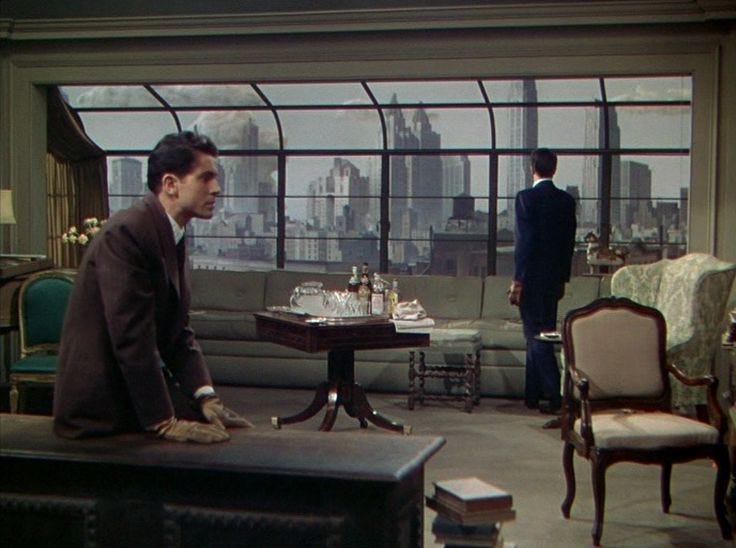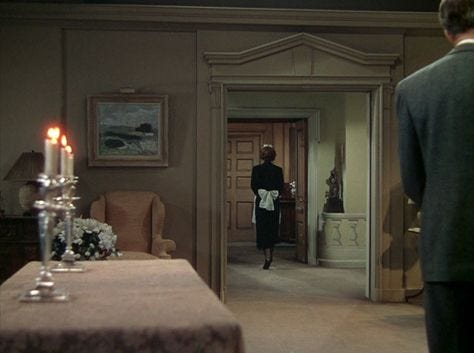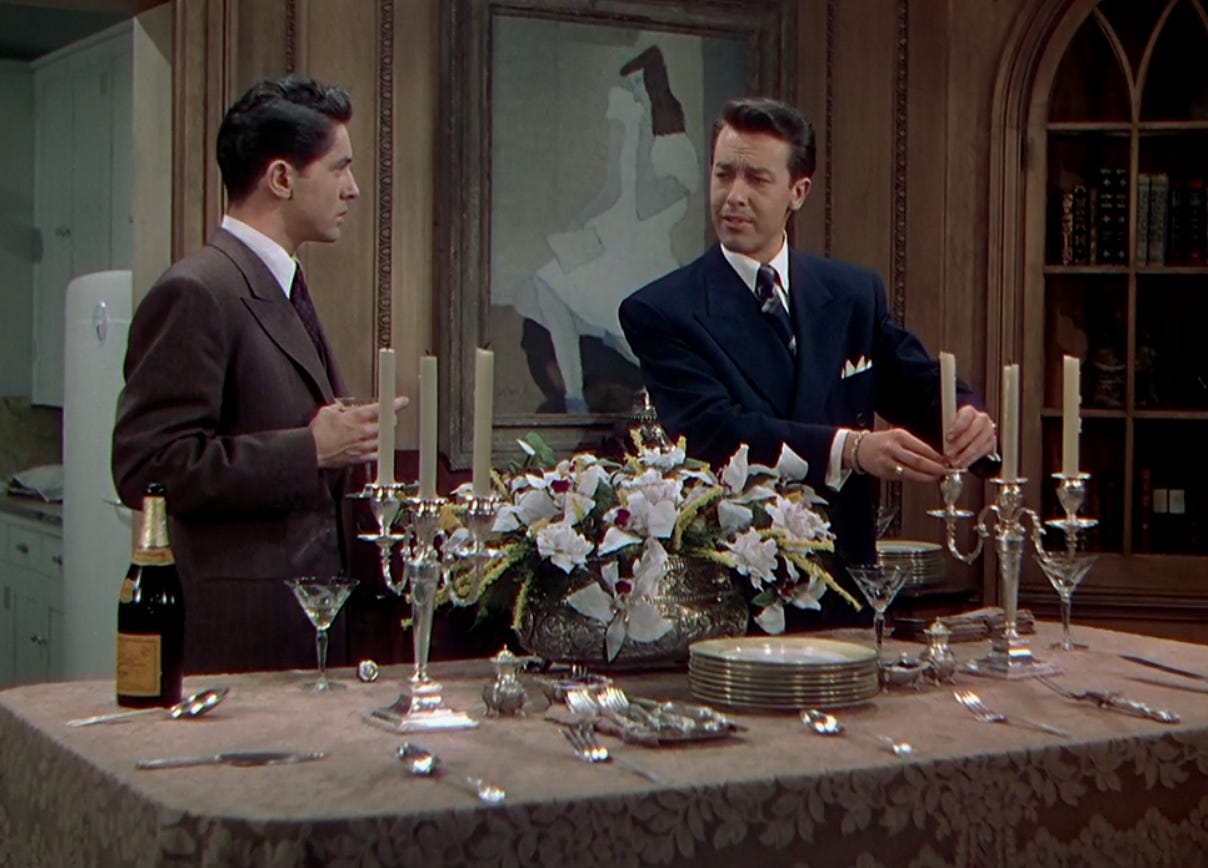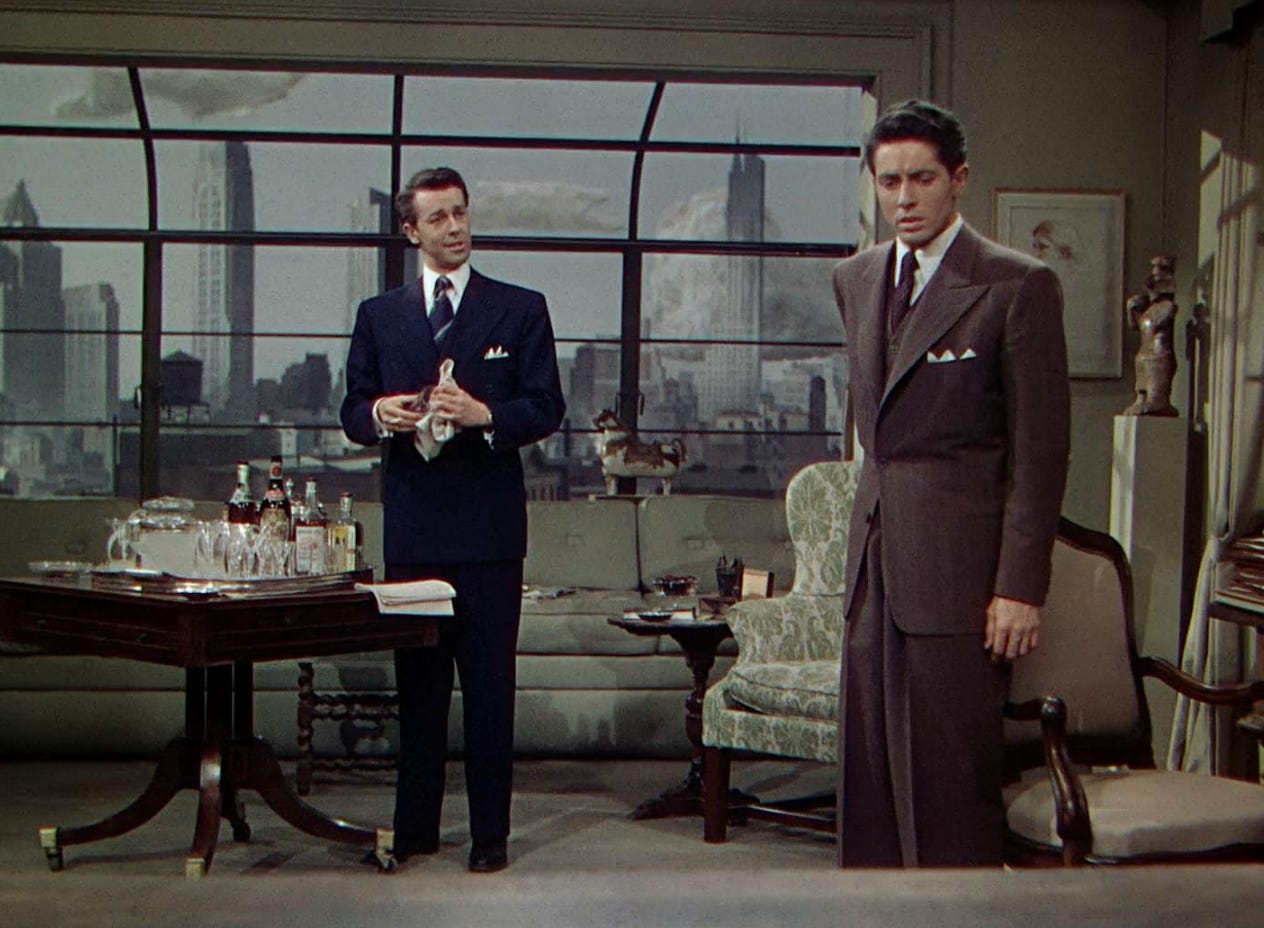There are so many fictional yet desirable NYC apartments – Carrie Bradshaw’s, and any in Nora Ephron’s oeuvre come to mind. But my favorite is the one in Alfred Hitchcock’s Rope (1948) which I think embodies a Manhattan ideal. It’s not Hitchcock’s most famous New York apartment movie (Rear Window takes that title), but Rope is one of his most inventive works. The entire movie appears as one, long take (in fact there were a few cleverly hidden cuts). Because all the action takes place in the apartment, the interior design is crucial to the plot.
Note: spoilers for a 77-year-old movie!
The premise
The gist is this: a pair of upper-class guys in their mid-20s (Brandon and Philip, played by John Dall and Farley Granger, respectively) get bored and decide to strangle one of their peers, David, because he wasn’t on their level. Influenced by Nietzsche’s ideas of the “uber-mensch,” Brandon and Philip see themselves as superior beings above morality. The murder happens in the opening seconds of the movie.
The rest of the movie is about the pair’s audacity to 1) immediately host a dinner party with David’s body hidden in the same room and 2) only invite the dead man’s loved ones – including David’s girlfriend, best friend, father and aunt. Also in attendance is Rupert (Jimmy Stewart), a former mentor and vibes detective.
Brandon, a charming psychopath, finds the possibility of discovery exhilarating. Philip, a remorseful hothead, is jittery over everything coming out of Brandon’s mouth. What could go wrong?
This movie is so many things. It’s a cat-and-mouse thriller. It’s an early example of queer cinema.1 It’s also funny, and has modern touches like a discussion of astrology. Most importantly, it’s a rebuke of fascism and ideas of “superior beings” — especially powerful since it was made in 1948. Jimmy Stewart gets to monologue at the end and it’s glorious to watch. At 80 minutes, it's efficient yet satisfying on every rewatch.
Despite most of the action taking place in the living room, Rope very much has some great interior details:
Location
The actual apartment is a stage set in California, but it’s based on a real Manhattan location – according to iMDB, that location is at East 54th Street and 2nd Ave, with the main living room windows facing west. Because the living room has an adjacent wall with north-facing windows, I believe their apartment is meant to be a corner apartment on the southeast corner (and the current-day building is a high-rise above a liquor store and dry cleaners).
Layout
It’s a one-bedroom — there’s mention of a bedroom, singular (which adds to the gay subtext). There’s a kitchen, dining area, hallway, foyer, living room. We never see the bedroom. 90% of the movie is shot in the living room. If I had to guess, the apartment is approximately 1,000-1,200 square feet, based on the aforementioned details.
On character taste
Traditional, with a twist
Brandon and Philip’s apartment is mostly traditional, reflected in the layout, as well as the dining chairs, card table, lamps, and piano. But there are modern touches of the abstract art and the streamlined banquette sofa.

Roman
There’s a nod to the Roman era as well (the crown molding, and tromp l’oeil column wall illustrations). These are applied to the facade of the walls around the doorways. You could potentially tie this to being a metaphor for their approach to Nietzsche and any “superior beings” philosophy — aspiring to their interpretation of ideal forms, but ultimately a facsimile and a degradation of the real thing. The doorway’s crown molding also adds to a stage-like feeling — a frame within a frame.

Gothic
There are also Gothic elements — the dead body in the cassone chest, the dining room’s cathedral-like wood cabinet, the candelabras.2 Brandon calls the cassone a “ceremonial altar” for their feast. A lot of action happens around the cassone, and yet we only see it from above and behind (almost like we the audience have the POV of David’s ghost).
These details add a funereal touch to the apartment.

Some specific callouts
The windows. Even though this movie was filmed on a set, the windows are alive — the clouds move, and the lighting changes to seem like a full night has passed in the span of 80 minutes. Hitchcock likes “scene within a scene” windows, which he later utilizes in Vertigo and Rear Window. These windows also have discreet curtains (were Brandon and Philip ahead of their time with rich people windows?). It took me a couple viewings to realize it was a set.

The inset bookshelves. The shelves are in the background of most shots, a reminder of the hosts’ intellectual pursuits. I imagine Dorian Grey, The Mistletoe Bough, and some of Rupert’s obscure titles are on those shelves.
The swinging kitchen door. Practical to hide the party setup (and murder weapon).
The neon sign: This would drive me crazy irl but they do have curtains. The sign spells “STORAGE” which I realize now is a huge clue to this murder – David’s body is hidden in storage (the cassone).
The piano: Everything you need to know about Philip is through his piano. It’s a symbol of his deteriorating mental health and fear of discovery as his playing becomes more clumsy throughout the night.
The green wingback armchair: It’s where David takes his last drink offscreen before he’s murdered, and it’s where Rupert builds on his suspicions. Rupert is the only character to sit in the chair through the duration of the movie.

What’s interesting is the apartment is a physical manifestation of Brandon and Philip’s motive – they see themselves as tastemakers, and they think they can do anything in a superior, artful way. In the end, they’re undone by these beliefs and they will lose this apartment.
Despite all this, I do think they have damn good style that’s aged really well.
Some modern ways to incorporate their aesthetics (no murder necessary):

Extended reading:
Never given a close look to Hitchcock? Start here | NY Times (gift link)
How Hitchcock altered architecture on the silver screen | Elle Decor
How Hitchcock’s Classic Mystery Rope Cleverly Depicted Queer Life | Out
Alfred Hitchcock’s First Color Movie is Secretly a LGBTQ+ Masterpiece | Screenrant
A Gothic approach to Rope | Cine Gratia Cinema
Hitchcock and Post-war Modernism | Film and Furniture
Hitchcock inspired interiors in a hotel | Film and Furniture
It’s never explicitly said but Brandon and Philip are a couple, and Rupert is potentially an ex-lover (probably Brandon’s). It’s all subtext because of the Hays Code governing Hollywood morality at the time. There’s been debate over the years whether villainizing the gay characters is inclusive or exploitative. See more in the extended reading about the gay subtext in Hitchcock’s work.
Also references to The Mistletoe Bough story, a ghost story about a dead body in a chest. See this piece for more on Gothic elements in the movie.


















ummm i'm embarrassed to admit to you that i've never seen this movie but this interiors deep dive definitely makes me want to!!